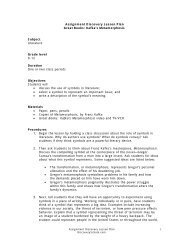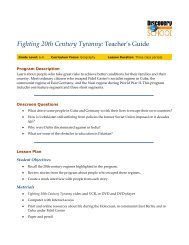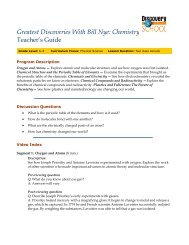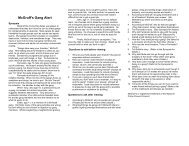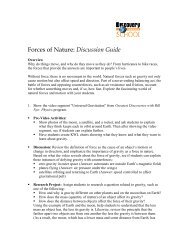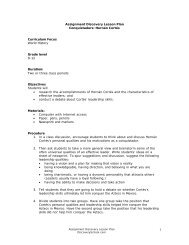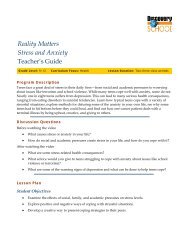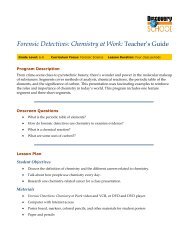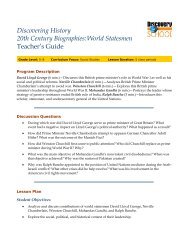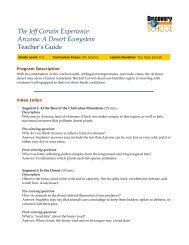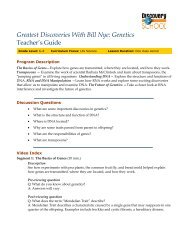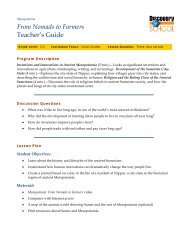Elements of Earth Science The Universe and the Solar System
Elements of Earth Science The Universe and the Solar System
Elements of Earth Science The Universe and the Solar System
You also want an ePaper? Increase the reach of your titles
YUMPU automatically turns print PDFs into web optimized ePapers that Google loves.
<strong>Elements</strong> <strong>of</strong> <strong>Earth</strong> <strong>Science</strong><br />
<strong>The</strong> <strong>Universe</strong> <strong>and</strong> <strong>the</strong> <strong>Solar</strong> <strong>System</strong><br />
Teacher’s Guide<br />
Grade Level: 6–12 Curriculum Focus: <strong>Earth</strong> <strong>Science</strong> Lesson Duration: Two class periods<br />
Program Description<br />
Explore scientific <strong>the</strong>ories about <strong>the</strong> origin <strong>of</strong> <strong>the</strong> universe, <strong>the</strong> formation <strong>of</strong> stars, planets, <strong>and</strong> galaxies.<br />
Learn why <strong>Earth</strong> is <strong>the</strong> only planet in our solar system capable <strong>of</strong> supporting life, what effect comets<br />
<strong>and</strong> asteroids have on <strong>the</strong> planet, <strong>and</strong> how <strong>the</strong> moon influences <strong>the</strong> tides.<br />
Onscreen Questions<br />
How does modern science explain <strong>the</strong> origins <strong>and</strong> development <strong>of</strong> <strong>the</strong> universe?<br />
What existed before <strong>the</strong> big bang?<br />
Will <strong>the</strong> universe exp<strong>and</strong> forever?<br />
How are stars <strong>and</strong> galaxies formed?<br />
What are <strong>the</strong> origins <strong>and</strong> forces that shaped our solar system?<br />
How are <strong>the</strong> planets alike, <strong>and</strong> how are <strong>the</strong>y different?<br />
How are comets, asteroids, <strong>and</strong> meteorites alike, <strong>and</strong> how are <strong>the</strong>y different?<br />
How do <strong>the</strong> <strong>Earth</strong>’s shape, orbit, <strong>and</strong> <strong>the</strong> tilt <strong>of</strong> its axis determine <strong>the</strong> seasons?<br />
Lesson Plan<br />
Student Objectives<br />
Underst<strong>and</strong> <strong>the</strong> big bang <strong>and</strong> <strong>the</strong> origins <strong>of</strong> <strong>the</strong> universe.<br />
Determine similarities <strong>and</strong> differences between <strong>the</strong> planets.<br />
Explain why <strong>Earth</strong> is <strong>the</strong> only planet capable <strong>of</strong> supporting life.
<strong>Elements</strong> <strong>of</strong> <strong>Earth</strong> <strong>Science</strong>: <strong>The</strong> <strong>Universe</strong> <strong>and</strong> <strong>the</strong> <strong>Solar</strong> <strong>System</strong><br />
Teacher’s Guide<br />
Materials<br />
Procedures<br />
<strong>The</strong> <strong>Universe</strong> <strong>and</strong> <strong>the</strong> <strong>Solar</strong> <strong>System</strong> video<br />
Computer with Internet access<br />
Print research materials<br />
Travel brochures to a wide variety <strong>of</strong> destinations, <strong>the</strong> more exotic <strong>and</strong> faraway <strong>the</strong> better<br />
Desktop publishing program or paper <strong>and</strong> markers<br />
1. Discuss what it might be like to be a space traveler.<br />
2. H<strong>and</strong> out <strong>the</strong> travel brochures. Ask students if <strong>the</strong> brochures make <strong>the</strong>m feel excited about<br />
traveling to <strong>the</strong> places described. If students say yes, tell <strong>the</strong> students <strong>the</strong> travel brochures have<br />
done <strong>the</strong>ir job. Ask students to point out specific words <strong>and</strong> pictures in <strong>the</strong> brochures that make<br />
<strong>the</strong> places seem inviting.<br />
3. Discuss <strong>the</strong> factors that make a place a good travel destination. Students can infer <strong>the</strong>se factors<br />
from <strong>the</strong> brochures or from <strong>the</strong>ir own experiences.<br />
4. Tell students that <strong>the</strong>y will be creating travel brochures for some very exotic, faraway places—<br />
<strong>the</strong> o<strong>the</strong>r eight planets <strong>of</strong> <strong>the</strong> solar system.<br />
5. Divide your class into eight groups, <strong>and</strong> assign each group a planet. <strong>The</strong> students should begin<br />
by researching <strong>the</strong>ir planet. <strong>The</strong>y should list all <strong>of</strong> <strong>the</strong> scientific details <strong>the</strong>y can find, including<br />
such things as <strong>the</strong> planet’s size, composition, surface features, satellites, distance from <strong>the</strong> sun<br />
<strong>and</strong> <strong>Earth</strong>, <strong>and</strong> its relationship to o<strong>the</strong>r planets in <strong>the</strong> solar system.<br />
<strong>The</strong> following web sites have useful information about <strong>the</strong> planets <strong>and</strong> <strong>the</strong> solar system. <strong>The</strong>y<br />
are a good starting point for exploring this topic:<br />
• http://amazing-space.stsci.edu/eds/astronomy-basics.php - solarsystem<br />
• http://www.nineplanets.org/<br />
• http://space.jpl.nasa.gov/<br />
• http://csep10.phys.utk.edu/astr161/lect/<br />
• http://www.windows.ucar.edu/tour/link=/our_solar_system/solar_system.html<br />
6. Have students use <strong>the</strong>ir imaginations to invent details like those in <strong>the</strong> travel brochures <strong>the</strong>y<br />
read. For example, <strong>the</strong>ir brochures might cover things like accommodations, restaurants,<br />
recreational activities, sites to tour, wea<strong>the</strong>r conditions, travel <strong>and</strong> dress requirements, <strong>and</strong><br />
indigenous life forms, if any. Students should be sure to call attention to some au<strong>the</strong>ntic details<br />
about <strong>the</strong> planet in question. For example, students working with <strong>the</strong> planet Mars could plan a<br />
sightseeing expedition to Olympus Mons, an extraordinarily large <strong>and</strong> active volcano on Mars'<br />
surface.<br />
Published by Discovery Education. © 2005. All rights reserved.<br />
2
<strong>Elements</strong> <strong>of</strong> <strong>Earth</strong> <strong>Science</strong>: <strong>The</strong> <strong>Universe</strong> <strong>and</strong> <strong>the</strong> <strong>Solar</strong> <strong>System</strong><br />
Teacher’s Guide<br />
7. Have students sketch out <strong>the</strong>ir brochure on a piece <strong>of</strong> paper. Remind <strong>the</strong>m to use pictures,<br />
graphics, <strong>and</strong> words to “sell” <strong>the</strong>ir planet. Once <strong>the</strong>y’ve designed <strong>the</strong> brochure have <strong>the</strong>m<br />
create it on a computer or with paper.<br />
8. Have <strong>the</strong> groups exchange <strong>and</strong> evaluate each o<strong>the</strong>r's brochures. Have <strong>the</strong>m respond to <strong>the</strong>se<br />
questions:<br />
Assessment<br />
• Does <strong>the</strong> brochure include information about <strong>the</strong> planet that is scientifically accurate?<br />
• Does <strong>the</strong> brochure do a good job <strong>of</strong> "selling" <strong>the</strong> proposed planetary trip?<br />
Use <strong>the</strong> following three-point rubric to evaluate students' work during this lesson.<br />
Vocabulary<br />
3 points: Students were highly engaged in class discussions; conducted thorough research;<br />
created an attractive <strong>and</strong> informative brochure.<br />
2 points: Students were somewhat engaged in class discussions; conducted adequate research;<br />
created an acceptable brochure.<br />
1 point: Students were not engaged in class discussions; conducted inadequate research;<br />
did not complete an acceptable brochure.<br />
atmosphere<br />
Definition: <strong>The</strong> envelope <strong>of</strong> gases that surround a planet or celestial body<br />
Context: <strong>Earth</strong> is <strong>the</strong> only planet with an atmosphere <strong>of</strong> oxygen <strong>and</strong> nitrogen.<br />
big bang<br />
Definition: <strong>The</strong> <strong>the</strong>ory that <strong>the</strong> universe began with <strong>the</strong> explosion <strong>of</strong> a single infinitesimally<br />
small <strong>and</strong> dense point<br />
Context: Scientists believe that at <strong>the</strong> instant <strong>of</strong> <strong>the</strong> big bang all <strong>the</strong> matter in <strong>the</strong> universe began<br />
to exp<strong>and</strong> outward at tremendous speed.<br />
galaxy<br />
Definition: A very large groups <strong>of</strong> stars <strong>and</strong> associated matter<br />
Context: A galaxy may contain hundreds <strong>of</strong> billions <strong>of</strong> stars.<br />
inner planets<br />
Definition: <strong>The</strong> four planets closest to <strong>the</strong> sun —Mercury, Venus, <strong>Earth</strong>, <strong>and</strong> Mars<br />
Context: <strong>The</strong> inner planets are composed primarily <strong>of</strong> rock <strong>and</strong> metal, <strong>and</strong> are relatively small.<br />
meteorites<br />
Definition: A meteor that reaches <strong>the</strong> surface <strong>of</strong> <strong>the</strong> <strong>Earth</strong><br />
Context: Most meteorites are small, leaving little impact when <strong>the</strong>y reach <strong>the</strong> ground, but some<br />
can create large craters, such as <strong>the</strong> Barringer Crater in Arizona.<br />
Published by Discovery Education. © 2005. All rights reserved.<br />
3
<strong>Elements</strong> <strong>of</strong> <strong>Earth</strong> <strong>Science</strong>: <strong>The</strong> <strong>Universe</strong> <strong>and</strong> <strong>the</strong> <strong>Solar</strong> <strong>System</strong><br />
Teacher’s Guide<br />
St<strong>and</strong>ards<br />
outer planets<br />
Definition: <strong>The</strong> five planets far<strong>the</strong>st from <strong>the</strong> sun—Jupiter, Saturn, Uranus, Neptune, <strong>and</strong> Pluto<br />
Context: Except for Pluto, <strong>the</strong> outer planets are composed mainly <strong>of</strong> hydrogen <strong>and</strong> helium gas<br />
<strong>and</strong> liquid, <strong>and</strong> are also known as “gas giants.”<br />
singularity<br />
Definition: A point or region <strong>of</strong> infinite mass at which space <strong>and</strong> time are infinitely distorted by<br />
gravitational forces <strong>and</strong> which is held to be <strong>the</strong> final state <strong>of</strong> matter falling into a black hole<br />
Context: Scientists believe that 14 or 15 billion years ago, all <strong>the</strong> matter in <strong>the</strong> universe was<br />
contracted to a singularity.<br />
National Academy <strong>of</strong> <strong>Science</strong>s<br />
<strong>The</strong> National Academy <strong>of</strong> <strong>Science</strong>s provides guidelines for teaching science in grades K–12 to<br />
promote scientific literacy. To view <strong>the</strong> st<strong>and</strong>ards, visit this Web site:<br />
http://books.nap.edu/html/nses/html/overview.html#content.<br />
This lesson plan addresses <strong>the</strong> following national st<strong>and</strong>ards:<br />
• <strong>Earth</strong> <strong>and</strong> Space <strong>Science</strong>: Origin <strong>and</strong> evolution <strong>of</strong> <strong>the</strong> universe; <strong>Earth</strong> in <strong>the</strong> solar system<br />
Mid-continent Research for Education <strong>and</strong> Learning (McREL)<br />
McREL's Content Knowledge: A Compendium <strong>of</strong> St<strong>and</strong>ards <strong>and</strong> Benchmarks for K-12 Education<br />
addresses 14 content areas. To view <strong>the</strong> st<strong>and</strong>ards <strong>and</strong> benchmarks, visit<br />
http://www.mcrel.org/compendium/browse.asp<br />
This lesson plan addresses <strong>the</strong> following national st<strong>and</strong>ards:<br />
• <strong>Science</strong>: <strong>Earth</strong> <strong>and</strong> Space <strong>Science</strong>s—Underst<strong>and</strong>s <strong>the</strong> composition <strong>and</strong> structure <strong>of</strong> <strong>the</strong><br />
universe <strong>and</strong> <strong>the</strong> <strong>Earth</strong>'s place in it<br />
• <strong>Science</strong>: Physical <strong>Science</strong>s—Underst<strong>and</strong>s <strong>the</strong> structure <strong>and</strong> properties <strong>of</strong> matter<br />
Support Materials<br />
Develop custom worksheets, educational puzzles, online quizzes, <strong>and</strong> more with <strong>the</strong> free teaching tools<br />
<strong>of</strong>fered on <strong>the</strong> Discoveryschool.com Web site. Create <strong>and</strong> print support materials, or save <strong>the</strong>m to a<br />
Custom Classroom account for future use. To learn more, visit<br />
• http://school.discovery.com/teachingtools/teachingtools.html<br />
Published by Discovery Education. © 2005. All rights reserved.<br />
4
<strong>Elements</strong> <strong>of</strong> <strong>Earth</strong> <strong>Science</strong>: <strong>The</strong> <strong>Universe</strong> <strong>and</strong> <strong>the</strong> <strong>Solar</strong> <strong>System</strong><br />
Teacher’s Guide<br />
DVD Content<br />
This program is available in an interactive DVD format. <strong>The</strong> following information <strong>and</strong> activities are<br />
specific to <strong>the</strong> DVD version.<br />
How To Use <strong>the</strong> DVD<br />
<strong>The</strong> DVD starting screen has <strong>the</strong> following options:<br />
Play Video—This plays <strong>the</strong> video from start to finish. <strong>The</strong>re are no programmed stops, except by<br />
using a remote control. With a computer, depending on <strong>the</strong> particular s<strong>of</strong>tware player, a pause<br />
button is included with <strong>the</strong> o<strong>the</strong>r video controls.<br />
Video Index—Here <strong>the</strong> video is divided into sections indicated by video thumbnail icons. Watching<br />
all parts in sequence is similar to watching <strong>the</strong> video from start to finish. Brief descriptions <strong>and</strong> total<br />
running times are noted for each part. To play a particular segment, press Enter on <strong>the</strong> remote for<br />
TV playback; on a computer, click once to highlight a thumbnail <strong>and</strong> read <strong>the</strong> accompanying text<br />
description <strong>and</strong> click again to start <strong>the</strong> video.<br />
Curriculum Units—<strong>The</strong>se are specially edited video segments pulled from different sections <strong>of</strong> <strong>the</strong><br />
video (see below). <strong>The</strong>se nonlinear segments align with key ideas in <strong>the</strong> unit <strong>of</strong> instruction. <strong>The</strong>y<br />
include onscreen pre- <strong>and</strong> post-viewing questions, reproduced below in this Teacher’s Guide. To<br />
play a particular segment, press Enter on <strong>the</strong> TV remote or click once on <strong>the</strong> Curriculum Unit title<br />
on a computer.<br />
St<strong>and</strong>ards Link—Selecting this option displays a single screen that lists <strong>the</strong> national academic<br />
st<strong>and</strong>ards <strong>the</strong> video addresses.<br />
Teacher Resources—This screen gives <strong>the</strong> technical support number <strong>and</strong> Web site address.<br />
Video Index<br />
I. <strong>The</strong> Big Bang <strong>and</strong> <strong>the</strong> Origin <strong>of</strong> <strong>the</strong> <strong>Universe</strong> (4 min.)<br />
Scientists believe that all <strong>the</strong> matter in <strong>the</strong> universe was once condensed into a single, infinitesimal<br />
point, <strong>and</strong> <strong>the</strong>n, in an instant, everything began to exp<strong>and</strong>.<br />
Pre-viewing question:<br />
Q: How does modern science explain <strong>the</strong> origins <strong>and</strong> development <strong>of</strong> <strong>the</strong> universe?<br />
A: Answers will vary.<br />
Post-viewing question:<br />
Q: What existed before <strong>the</strong> big bang? Will <strong>the</strong> universe exp<strong>and</strong> forever?<br />
A: No one knows for sure, but scientists believe that an infinitesimally small point, called a<br />
singularity, held all <strong>the</strong> matter <strong>of</strong> <strong>the</strong> universe. <strong>The</strong> universe exp<strong>and</strong>ed outward at tremendous<br />
speed, forming everything that exists, including galaxies, planets, rocks, <strong>and</strong> living things. One<br />
<strong>the</strong>ory says <strong>the</strong> universe will exp<strong>and</strong> forever. Ano<strong>the</strong>r holds that at a certain point, gravity will pull<br />
all matter back toge<strong>the</strong>r until <strong>the</strong>re is a new singularity.<br />
Published by Discovery Education. © 2005. All rights reserved.<br />
5
<strong>Elements</strong> <strong>of</strong> <strong>Earth</strong> <strong>Science</strong>: <strong>The</strong> <strong>Universe</strong> <strong>and</strong> <strong>the</strong> <strong>Solar</strong> <strong>System</strong><br />
Teacher’s Guide<br />
II. Stars, Galaxies <strong>and</strong> <strong>the</strong> Milky Way (5 min.)<br />
Stars <strong>and</strong> galaxies form in <strong>the</strong> interstellar gas <strong>and</strong> dust leftover from <strong>the</strong> big bang.<br />
Pre-viewing question:<br />
Q: How are stars <strong>and</strong> galaxies formed?<br />
A: Answers will vary.<br />
Post-viewing question:<br />
Q: What shapes <strong>and</strong> features do galaxies have?<br />
A: Galaxies can be spiral, such as our Milky Way, containing dust <strong>and</strong> stars surrounding a central<br />
bulge. New stars form in <strong>the</strong> spiral arms. Irregular galaxies have no particular shape, but are <strong>the</strong><br />
location <strong>of</strong> new star formation. Elliptical galaxies are rounder or more oval-shaped. <strong>The</strong>y have<br />
converted almost all <strong>of</strong> <strong>the</strong>ir gaseous material <strong>and</strong> are not creating new stars.<br />
III. <strong>The</strong> Origin <strong>of</strong> <strong>the</strong> <strong>Solar</strong> <strong>System</strong> (6 min.)<br />
Gravity caused gas <strong>and</strong> dust to collapse <strong>and</strong> condense billions <strong>of</strong> years ago to form <strong>the</strong> sun <strong>and</strong> <strong>the</strong><br />
planets in <strong>the</strong> solar system.<br />
Pre-viewing question:<br />
Q: What are <strong>the</strong> origins <strong>and</strong> forces that shaped our solar system?<br />
A: Answers will vary.<br />
Post-viewing question:<br />
Q: How did <strong>the</strong> sun impact <strong>the</strong> formation <strong>of</strong> our solar system’s planets?<br />
A: Closer to <strong>the</strong> sun, planets formed from heavier atoms, <strong>and</strong> are primarily composed <strong>of</strong> rock <strong>and</strong><br />
metal. In <strong>the</strong> colder regions far<strong>the</strong>r from <strong>the</strong> sun, <strong>the</strong> planets are mostly composed <strong>of</strong> gases like<br />
hydrogen <strong>and</strong> helium. <strong>The</strong> sun’s mass creates a strong gravitational field that holds <strong>the</strong> planets <strong>and</strong><br />
o<strong>the</strong>r materials in orbit around it.<br />
IV. <strong>The</strong> Inner <strong>and</strong> Outer Planets (5 min.)<br />
<strong>The</strong> planets in our solar system have similarities <strong>and</strong> differences, but only <strong>Earth</strong> supports life.<br />
Pre-viewing question:<br />
Q: How are <strong>the</strong> planets alike <strong>and</strong> how are <strong>the</strong>y different?<br />
A: Answers will vary.<br />
Post-viewing question:<br />
Q: What are some <strong>of</strong> <strong>the</strong> unique features <strong>of</strong> <strong>the</strong> inner planets?<br />
A: <strong>Earth</strong> <strong>and</strong> Venus still retain heat in <strong>the</strong>ir cores. <strong>Earth</strong> is <strong>the</strong> only planet with an atmosphere <strong>of</strong><br />
oxygen <strong>and</strong> nitrogen, capable <strong>of</strong> supporting life. Seventy-one percent <strong>of</strong> <strong>Earth</strong> is also covered with<br />
water, while o<strong>the</strong>r planets only have small amounts. Mercury <strong>and</strong> Venus are <strong>the</strong> only planets<br />
without a moon.<br />
Published by Discovery Education. © 2005. All rights reserved.<br />
6
<strong>Elements</strong> <strong>of</strong> <strong>Earth</strong> <strong>Science</strong>: <strong>The</strong> <strong>Universe</strong> <strong>and</strong> <strong>the</strong> <strong>Solar</strong> <strong>System</strong><br />
Teacher’s Guide<br />
V. Comets, Asteroids, <strong>and</strong> Meteorites (5 min.)<br />
Comets, asteroids <strong>and</strong> meteors may be leftover debris from <strong>the</strong> big bang <strong>and</strong> some have impacted<br />
<strong>Earth</strong>.<br />
Pre-viewing question:<br />
Q: How are comets, asteroids, <strong>and</strong> meteorites alike <strong>and</strong> how are <strong>the</strong>y different?<br />
A: Answers will vary.<br />
Post-viewing question:<br />
Q: How have asteroids or meteorites left <strong>the</strong>ir mark on <strong>the</strong> <strong>Earth</strong>?<br />
A: Most meteorites leave little impact, but larger asteroids can strike <strong>the</strong> ground <strong>and</strong> create large<br />
craters, like <strong>the</strong> Barringer Crater in Arizona. It is now thought that a huge asteroid struck <strong>Earth</strong><br />
about 65 million years ago, leading to <strong>the</strong> extinction <strong>of</strong> <strong>the</strong> dinosaurs.<br />
VI. <strong>The</strong> <strong>Earth</strong>’s Orbit (5 min.)<br />
<strong>The</strong> orbit, rotation <strong>and</strong> tilt <strong>of</strong> <strong>Earth</strong> affect seasons, temperature, <strong>and</strong> climate.<br />
Pre-viewing question:<br />
Q: How do <strong>Earth</strong>’s shape, orbit <strong>and</strong> <strong>the</strong> tilt <strong>of</strong> its axis determine <strong>the</strong> seasons?<br />
A: Answers will vary.<br />
Post-viewing question:<br />
Q: What may be responsible for periods <strong>of</strong> warmer <strong>and</strong> cooler temperatures on <strong>the</strong> <strong>Earth</strong>?<br />
A: When <strong>the</strong> sun has fewer sunspots, it gives <strong>of</strong>f less energy; this is thought to be responsible for<br />
periods <strong>of</strong> cooler <strong>Earth</strong> temperatures. Changes in <strong>Earth</strong>’s orbit <strong>and</strong> tilt may also cause periods <strong>of</strong><br />
significant temperature change.<br />
Published by Discovery Education. © 2005. All rights reserved.<br />
7



